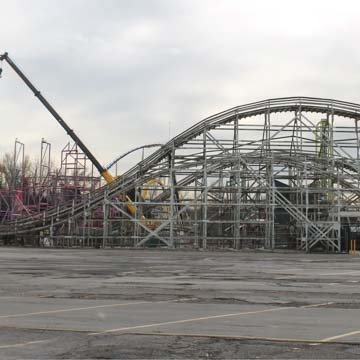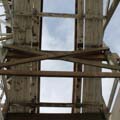The Lagoon Roller Coaster was built in 1921 by John Miller, who patented over 100 roller coaster components and designed over 140 rollercoasters over the course of his career, including the Thunderbolt (1925) in Coney Island, New York. The Lagoon Roller Coaster featured two of Miller’s major inventions: a safety ratchet that kept the cars from rolling backwards on a steep hill, and wheels under the rails that kept the roller coaster from flying off the tracks.
The roller coaster is part of Lagoon Amusement Park, which had its origins as Lake Park, first built in 1888 on the shore of Great Salt Lake, three miles west of Farmington. In 1899 the park moved to the bank of a 9-acre pond in Farmington, located halfway between Ogden and Salt Lake City; its name was then changed to Lagoon Park. The park introduced its first thrill ride, Shoot-the-Chutes, marking the transition from bathing resort to amusement park.
The Lagoon Roller Coaster is a massive structure that mimics railroad trestle construction, with wood joined by bolts and nails and supported on concrete foundations; steel plates and cross-bracing stabilize the joints. The cars of the coaster run on two flat steel tracks mounted on a laminated wooden bed. The 2,500 feet of track include 8 hills, the highest of which reaches 60 feet, and the cars run at a top speed of 45 miles per hour. The wood was painted white to protect it from the elements; however, as parts of the coaster were replaced over the years with treated wood, the painting is now unnecessary.
The ride loops around the track twice, and simulates, in an exaggerated and concentrated form, the experience of train travel with its hills, valleys, and curves. In its early years, visitors accessed the park via the interurban Salt Lake and Ogden Railway, which was owned by Simon Bamberger, co-owner of Lagoon Park. Later, as cars replaced trams and trains, visitors reached the park on U.S. Route 91, which was transformed into I-15 in 1974. Most of the Lagoon Roller Coaster now extends out into the expansive parking lot, reinforcing this connection to travel.
By the 1940s, Lagoon Park’s facilities needed upgrades and visitation was at an all-time low. The park closed during World War II and reopened in 1946 under the new management of the Freed Brothers (Robert, Dan, David, and Peter). A fire in 1953 destroyed much of the park, including the Lagoon Roller Coaster. The Freeds rebuilt and reopened the park the following year. During the 1960s, the Freeds worked to desegregate the park, which, until then, had only been accessible to white patrons.
Lagoon Park is now home to a water park, Pioneer Village (a collection of relocated historic buildings), and many other rides, including nine steel roller coasters. Lagoon Roller Coaster, however, remains the only wooden roller coaster in the park. It is also holds the distinction as the fourth oldest coaster in the United States and the seventh in the world.










